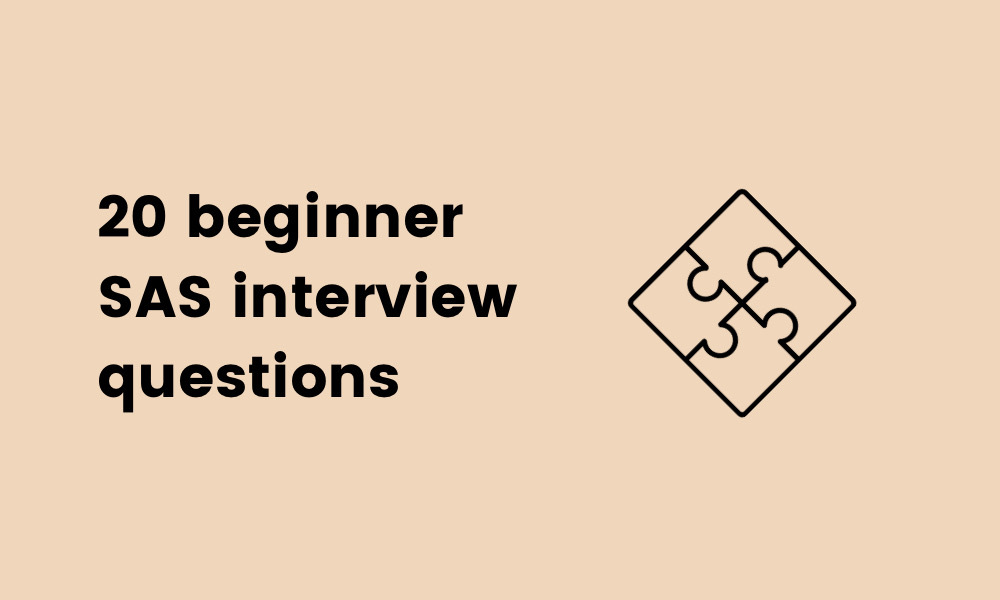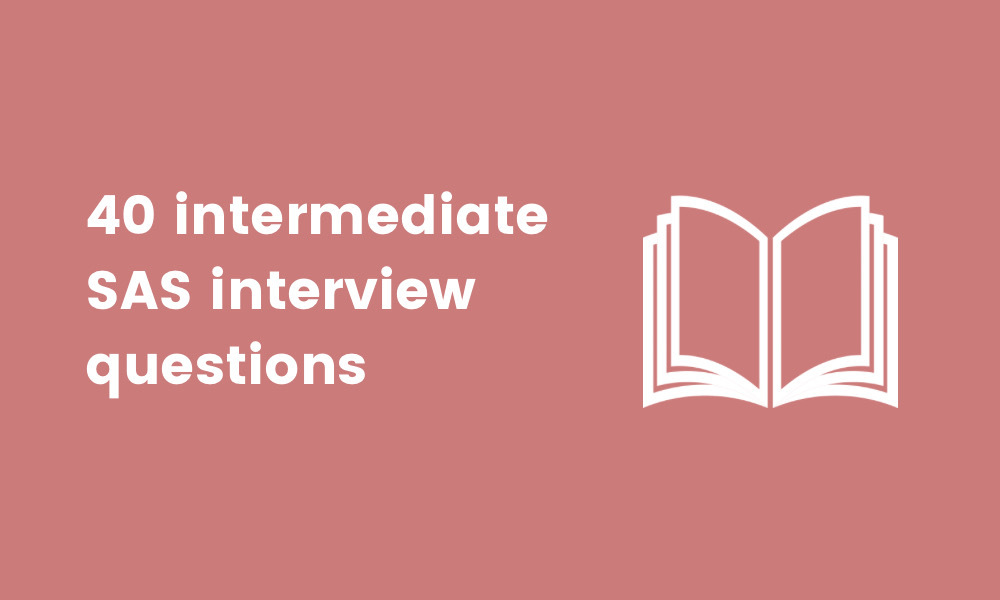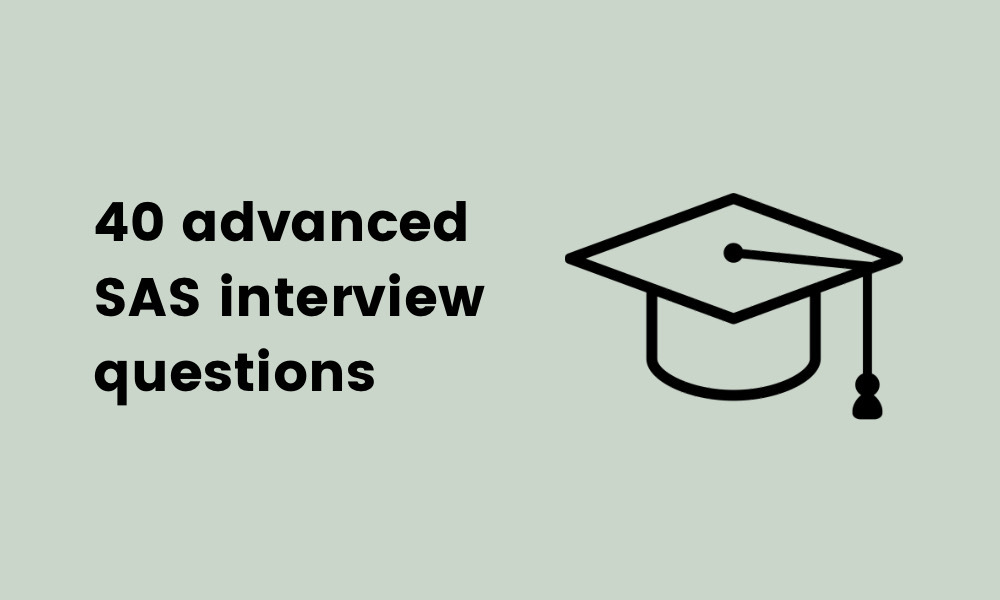100 SAS interview questions to hire the best data scientists
If you’re one of the many HR professionals searching for a SAS expert for your organization, you need to be able to evaluate their skills accurately, even if you’re not a proficient user of SAS’ tools yourself.
For this, it’s crucial to have the right set of interview questions to ask your candidates. However, it can be tricky to find questions that match your open position and reflect your organization’s requirements.
SAS interview questions for recruiters
That’s why we’ve compiled an extensive list of 100 SAS interview questions to help you prepare for the interview and evaluate the skills of your applicants.
So, are your candidates the right fit? Find out if they have the right data science and SAS skills using these SAS interview questions.
Table of contents
- 20 beginner SAS interview questions
- 5 sample answers to beginner SAS interview questions
- 40 intermediate SAS interview questions
- 5 sample answers to intermediate-level SAS interview questions
- 40 advanced SAS interview questions
- 5 sample answers to look for from your senior-level data scientist candidates
- At which stage of the hiring process should you use these SAS interview questions?
- Create a list of SAS interview questions to evaluate candidates’ skills and find your next data scientist
20 beginner SAS interview questions
The following section contains 20 beginner SAS interview questions to hire a data scientist. You can use them when hiring for junior-level roles, where candidates are expected to have little or no experience with SAS software.
For the best results, adapt the questions to your open position and its requirements.
How would you explain what SAS is?
In which industries is SAS used?
Which technical skills are required to use SAS?
What is debugging in SAS, and how would you debug a SAS program?
Which basic syntax style is used in SAS?
Can you explain what a SAS dataset is?
Can you explain the structure of SAS’ base program?
Which SAS versions have you used?
Which data types are contained in SAS?
How do you enhance your skills in SAS?
How do you ensure that your code is of high quality?
How do you stay up to date with new updates in SAS?
Can you explain what SAS’ data visualization tools are?
Which soft skills would be helpful or necessary when working with SAS?
What are some standard functions that SAS developers use?
What experience do you have with SAS macros?
What database sizes do you have experience with?
What challenges have you faced when using SAS to process data?
Which approaches do you use for conclusion validation for a dataset?
Which approaches do you use to explain a data report to someone non-technical?
5 sample answers to beginner SAS interview questions
Below, we have provided sample answers to five of the beginner SAS interview questions above. You can use them to gauge your candidates’ knowledge and skills.
1. How would you explain what SAS is?
SAS is an acronym that stands for “statistical analysis system”. It refers to a selection of software products that data scientists use for various statistical analyses.
SAS can help data scientists carry out some of the following actions:
Gain access to or retrieve data
Manipulate datasets and make changes to them
Analyze datasets and draw conclusions
Carry out numerical analysis
Write and build programs for data analysis
2. In which industries is SAS used?
There are a few industries in which SAS is typically used.
In addition to financial and banking organizations, where SAS is also specifically used for financial modeling and analyzing economic changes, software development companies and IT service providers often use SAS.
It’s ideal for the healthcare industry and is also used within governments for prescriptive or predictive analytics.
3. Which technical skills are required to use SAS?
Since SAS professionals have to handle data regularly, six of the critical technical skills they need include:
Advanced analytical skills
A solid understanding of databases
Knowledge of how to manipulate data
Knowledge of macros
4. What is debugging, and how would you debug a SAS program?
The debugging process involves finding and sorting out any errors discovered in a program.
Some common bugs include errors in syntax, errors in semantics, or data. To debug a program, I’d test the syntax and look at the logs to find the errors. I’d also test the smaller datasets in the program.
5. Which basic syntax style is used in SAS?
There are a few basic syntax styles that are used in SAS, including:
A semicolon at the end of the statements
A space used between the statement and the word
A data statement for defining the datasets
The best insights on HR and recruitment, delivered to your inbox.
Biweekly updates. No spam. Unsubscribe any time.
40 intermediate SAS interview questions
In this section, you’ll find 40 intermediate-level SAS interview questions. These are suited for candidates who already have a few years of experience with SAS. As always, adapt them to the requirements of the role you’re hiring for.
Describe four main capabilities of the SAS framework.
Which option would you use to minimize the decimal places in a variable with PROC MEANS?
What is meant by DATA Step? What does it do?
How would you use the index function?
Can you explain how SAS processes data values that are missing?
In SAS, how can you access an external data file?
In SAS, how can you access an internal data file?
What does PROC do in SAS?
What does PROC SORT do in SAS?
Can you describe what factor analysis is?
Are you aware of SAS’ special input delimiters? Could you name three?
Can you name two best practices when handling big datasets?
If you wanted to carry out a table lookup, how would you do this?
Can you name three errors you should avoid when using SAS?
What does the STOP statement do in SAS?
What are the advantages of using SAS?
What are SAS’ main features?
What is the use of the OUTPUT statement, and how does it work?
What does PROC SUMMARY do?
What does the CROSS LIST statement option do to tables in SAS?
In which situation would a SELECT construct be used over an IF statement?
Can you explain what linear regression is?
Can you explain how dates are represented in SAS?
What does the APPEND procedure do in SAS?
Can you explain the difference between DO WHILE and DO UNTIL?
Can a variable be a numeric data type if it has a letter or a special character?
In a PROC report, how are ORDER and GROUP different?
In PROC MEANS, how do the CLASS and BY statements differ?
If you wanted to combine datasets, how does merging make this easier?
Can you explain what interleaving is?
Can you explain the difference between match and one-to-one merge?
What does the DIVIDE function do?
What does the BOR function do?
What does the ANYDIGIT function do?
What approach do you use to handle a macro that has stopped working?
Which approach do you use to integrate various datasets with different formats?
Which approach would you use if you are unsure how to solve a programming problem in SAS?
Can you explain what SLIBREF is?
Can you explain how PROC CONTENTS is different from PROC PRINT?
Which process would you use to make a permanent dataset?
5 sample answers to intermediate-level SAS interview questions
Here are the sample answers to five of the above intermediate-level SAS interview questions, to give you an idea of what top responses should contain.
1. Can you explain what SLIBREF is?
SLIBREF, also known as server-libref, is used to indicate which libref the server uses to distinguish the library data in SAS even when a physical name is not specified.
2. Which approach would you use if you are unsure how to solve a programming problem in SAS?
Because SAS has a vast range of functions, it can be challenging to handle certain problems straightaway.
To solve a problem, I’d start by looking at the handbook. I might then consult forums that discuss the issue I need to tackle. If I were still unsure how to address it, I might communicate with my team members or team lead for extra assistance.
3. In which situation would a SELECT construct be used? When should an IF/THEN statement be used?
I’d use the SELECT construct if I have several conditions that are mutually exclusive, and the IF/THEN statement to produce a subset of the dataset’s input, if the program has few statements.
4. Describe four of the main capabilities of the SAS framework.
Four of the key capabilities of the SAS framework are:
Presenting data: With the SAS framework, you can present data in a wide range of forms: graphic reports, summaries or lists
Analyzing data: The SAS framework can analyze your data and initiate finding frequencies and averages
Managing data: In addition to data cleaning, the SAS framework helps you manage data, validate it, and produce variables
Accessing data: With the SAS framework, you can access data located in multiple sources, including Excel documents or databases in Oracle
5. If you wanted to combine datasets, how does merging make this easier?
By bringing together certain observations from various datasets in SAS, you will be left with one observation. MERGE statements also make it easier to carry out one-to-one merging while retaining the position of the observations in their datasets.
40 advanced SAS interview questions
Here are 40 advanced-level SAS interview questions for senior analyst positions. Choose from the list below to gain an in-depth understanding of your senior candidates’ skills.
How would you define what SAS storage is?
Can you explain what TRANWRD does in SAS?
Which factors signify efficiency in SAS?
How does %EVAL differ from %SYSEVALF?
What is the size of the most extensive dataset that SAS can hold?
Can you explain how Truncover and Missover are different?
Can you explain how INFILE and INPUT are different?
Can you explain how Informat and Format are different?
Why is double trailing (@@) used for Input Statements?
What do DROP and KEEP do to the variables of datasets?
When using PROC MEANS, which default statistics are provided?
Have you used any functions for cleaning data? Which ones have you used?
How is PROC different from FUNCTION?
Can you name four differences between the statements WHERE and IF?
Can you explain what PDV means?
Can you explain what DATA_NULL means?
How would you get rid of duplicate values?
How are NODUPKEY and NODUP different?
Can you explain what _NUMERIC_ is? What is its function?
Can you explain what _CHARACTER_ is? What is its function?
How would you sort data into descending order?
How would you change numeric into a character variable?
Which process would you follow to convert a character variable into a numeric variable?
How can you create a macro variable? Can you name four approaches?
How does SYMPUT differ from SYMGET?
How is SUBSTR different from SCAN?
Why is RETAIN used? What does it do?
What difference does the BY statement make when using Data Step Merge?
Is it possible to use the WHERE statement when sub-setting for newly derived variables?
How would you make comparisons between two tables using PROC SQL?
What does PROC SQL do?
What are the advantages of the PROC Report?
How would you generate a list output in PROC FREQ for cross-tabulations?
How do procedures and functions differ in SAS?
Can you describe what RUN-Group processing does in SAS?
What does the max() function do in SAS?
What does ODS mean in SAS?
Can you explain what data step processing involves?
Can you explain what the scan function does?
What is the difference between FLOOR and CEIL?
5 sample answers to look for from your senior-level data scientist candidates
The following section contains five sample answers that will help you gauge your senior-level applicants’ proficiency in SAS.
1. How would you generate a list output in PROC FREQ for cross-tabulations?
To achieve a list output in PROC FREQ for cross-tabulations, I’d use the PROC FREQ approach, table statement, in addition to variable names. I’d use a forward slash in the syntax and add LIST to your TABLES statement.
Here’s an example of the syntax that is required:
TABLES variable-1*variable-2* /LIST;
2. What does PROC SQL do?
The PROC SQL procedure brings together the DATA and the PROC steps into one step. This function facilitates the summarization, merging, sorting, and concatenation of datasets. It can even help the user produce new variables, make a new table, or see all data just by using this step.
3. Can you explain what data step processing involves?
There are a few steps involved in data step processing.
First, users submit the data, which SAS processes from the raw data file. Then, SAS will produce a new dataset. The process involves two stages—the compilation stage and the execution stage.
SAS will ensure the program features the right syntax rules in compilation, including naming conventions and semicolons. The DATA step works through the input data thoroughly and processes it in execution.
4. Can you explain what PDV means?
PDV stands for program data vector. It characterizes the logical area that pertains to the memory and produces or builds a dataset, one observation at a time.
5. How are NODUPKEY and NODUP different?
Whereas the NODUPKEY makes comparisons focusing only on the BY variable in the dataset and gets rid of observations that have duplicate BY values, NODUP makes comparisons between variables in the whole data and compares between current and previous observations.
At which stage of the hiring process should you use these SAS interview questions?
For the best results, our recommendation is to use these SAS interview questions during the final stages of your hiring process, when interviewing your best applicants.
To find out who they are, we advise you to administer a pre-employment skills assessment at the top of your hiring funnel, consisting of a few different skills tests. For SAS experts, you could decide to use a Data Science test, an Exploratory Data Analysis test, or a Working with Data test.
You can combine those with a cognitive ability assessment, a personality and culture test, or a programming skills test.
Once you’ve asked candidates to complete the skills tests that best match the requirements for the role, you’ll be able to quickly filter out unsuitable candidates and shortlist the best talent. This way, you can concentrate on your most skilled candidates only.
So, instead of interviewing tens of candidates who don’t have the skills needed for your role, you can use TestGorilla’s skills tests to save time and evaluate applicants’ skills objectively.
Create a list of SAS interview questions to evaluate candidates’ skills and find your next data scientist
Being prepared for the interview stage is essential for every HR professional and can make a huge difference to the candidate experience. For this reason, you need to prepare your list of SAS interview questions in advance, and know what to expect from candidates’ answers.
Even though this can be a bit challenging, you can use this article as guidance and select the right questions for the role.
Remember to combine a well-thought-out interview process with skill testing to ensure you source and interview exceptional data scientists and hire top talent for your team. Try TestGorilla for free.
You've scrolled this far
Why not try TestGorilla for free, and see what happens when you put skills first.

















